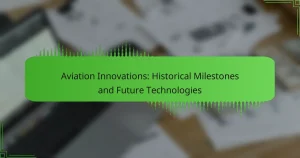Space travel is on the brink of a new era, driven by key technological advancements and ambitious missions. Innovations like reusable rocket systems and advanced propulsion technologies are reshaping exploration. Future missions aim to explore Mars, study asteroids, and utilise lunar resources. However, challenges such as funding constraints and safety concerns must be addressed to ensure success.
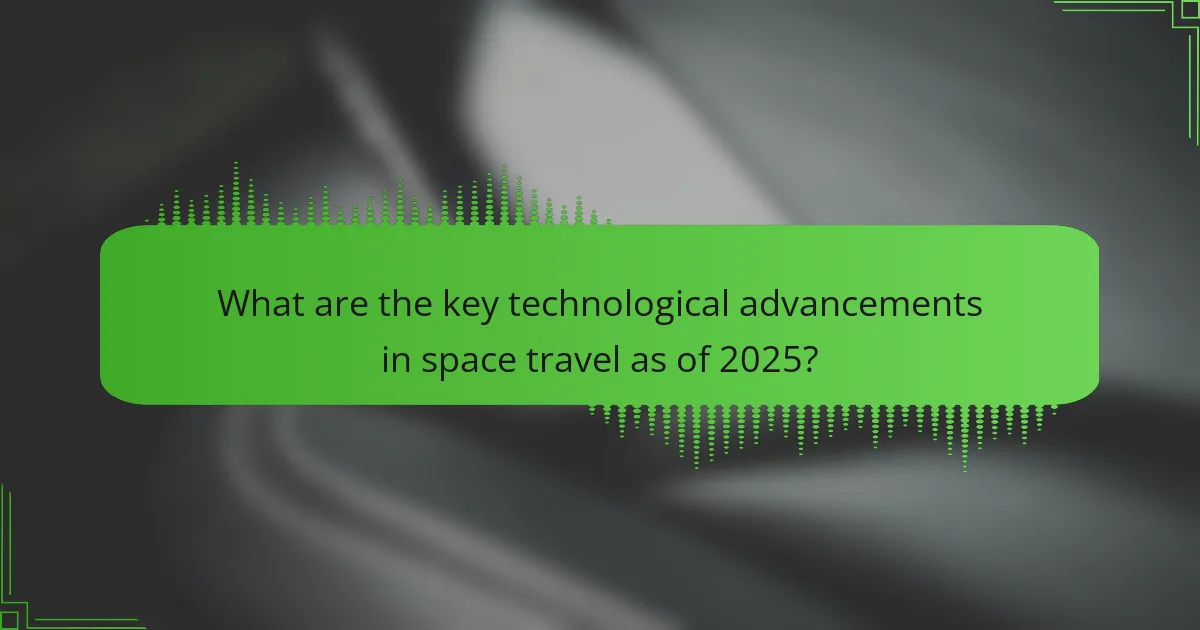
What are the key technological advancements in space travel as of 2025?
Key technological advancements in space travel by 2025 include reusable rocket systems, advanced propulsion technologies, artificial intelligence for navigation, and enhanced life support systems. Reusable rockets, like SpaceX’s Starship, significantly reduce costs. Ion propulsion systems improve efficiency for deep space missions. AI enhances autonomous navigation and mission planning. Life support systems now recycle air and water more effectively, crucial for long-duration missions. These innovations collectively push the boundaries of human exploration beyond Earth.
How has rocket propulsion evolved in recent years?
Rocket propulsion has significantly advanced through innovations in efficiency, reliability, and sustainability. Recent developments include the use of reusable rocket systems, such as SpaceX’s Falcon 9, which has reduced costs and increased launch frequency. Hybrid propulsion systems are gaining traction, combining traditional fuels with newer technologies to enhance performance. Moreover, research into green propellants aims to minimise environmental impact, showcasing a shift towards sustainable practices in space travel. These advancements not only improve current missions but also pave the way for future exploration, including Mars and beyond.
What role do reusable spacecraft play in reducing costs?
Reusable spacecraft significantly reduce costs by enabling multiple flights with the same vehicle. This approach minimises the need for new components, lowering manufacturing expenses. For example, SpaceX’s Falcon 9 has successfully reused boosters, resulting in launch costs dropping to around $2,700 per kilogram to low Earth orbit. Additionally, reusability enhances mission frequency, allowing for more efficient use of resources and technology. Overall, the financial impact of reusable spacecraft is transformative for future space exploration and commercial ventures.
Which innovations are enhancing astronaut safety and health?
Innovations enhancing astronaut safety and health include advanced life support systems, radiation shielding technologies, and telemedicine. These developments improve air quality, minimise radiation exposure, and enable remote medical assistance during missions. For example, the use of regenerative life support systems recycles air and water, significantly reducing resource dependency. Additionally, wearable health monitoring devices provide real-time data on astronauts’ physiological conditions, aiding in prompt medical responses. As a result, these innovations contribute to safer and healthier space travel experiences.

What are the objectives of upcoming space missions?
The objectives of upcoming space missions include advancing scientific knowledge, enhancing technology, and promoting international collaboration. These missions aim to explore Mars, study asteroids, and investigate the Moon’s resources. For instance, NASA’s Artemis programme focuses on sustainable lunar exploration to prepare for future Mars missions. Additionally, private companies are developing spacecraft to support commercial space travel and research. These endeavours will foster innovation and expand humanity’s presence in space.
How is NASA planning to return humans to the Moon?
NASA plans to return humans to the Moon through the Artemis programme, targeting 2024 for the first crewed lunar landing. This initiative focuses on sustainable exploration, utilising the Space Launch System (SLS) and the Orion spacecraft. Artemis aims to establish a lunar base, known as the Gateway, which will support future missions to Mars. Key technologies include advanced life support systems and lunar landers designed for long-duration stays. The programme also emphasises international collaboration and commercial partnerships to enhance capabilities and reduce costs.
What are the goals of the Artemis programme?
The goals of the Artemis programme include returning humans to the Moon, establishing a sustainable lunar presence, and preparing for future Mars missions. The programme aims to enhance international partnerships and develop new technologies for deep space exploration. Key objectives involve the use of lunar resources, scientific research, and advancing human spaceflight capabilities. Artemis is designed to inspire a new generation of explorers and foster innovation in space technology.
Which private companies are leading the charge for Mars exploration?
SpaceX, Blue Origin, and Lockheed Martin are leading private companies in Mars exploration. SpaceX aims to send humans to Mars by the mid-2020s with its Starship. Blue Origin focuses on lunar missions but has expressed interest in Mars. Lockheed Martin is developing the Mars Base Camp concept for human habitation. These companies are pivotal in advancing technology and planning future missions to the Red Planet.
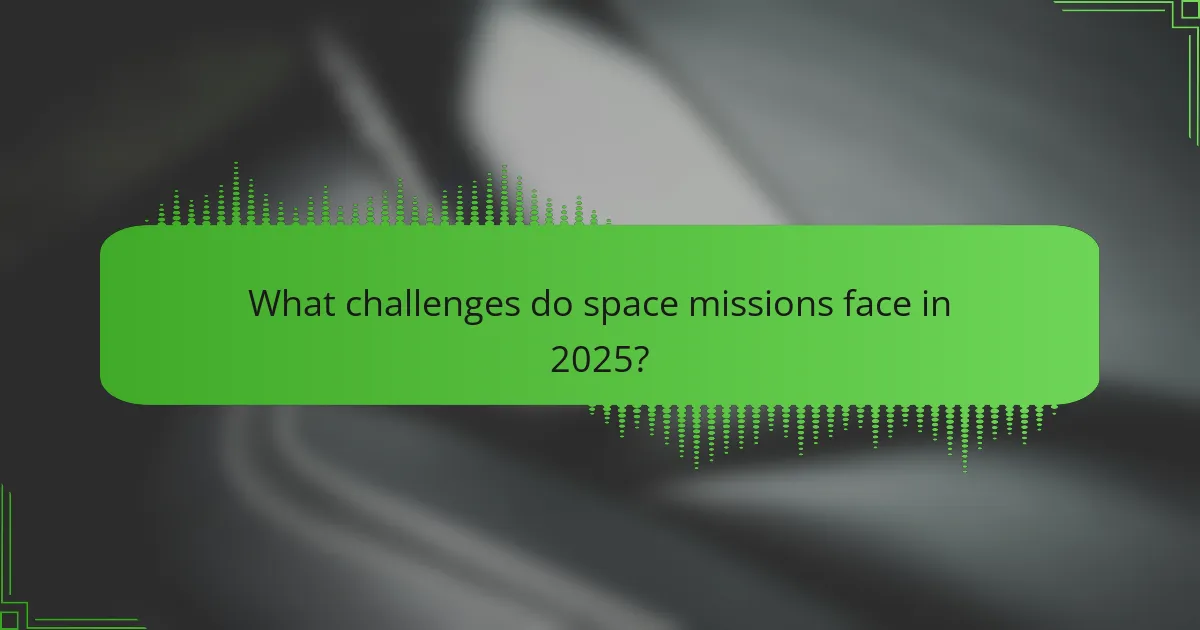
What challenges do space missions face in 2025?
Space missions in 2025 face challenges including technological limitations, funding constraints, and safety concerns. These factors impact mission planning and execution.
Technological limitations involve developing advanced propulsion systems and life-support technologies. Funding constraints arise from competing priorities within national budgets. Safety concerns include radiation exposure and the psychological effects of long-duration space travel.
Additionally, international collaboration is crucial for sharing resources and expertise. As missions aim for Mars and beyond, addressing these challenges will be vital for success.
How do funding and budget issues impact mission planning?
Funding and budget issues significantly impact mission planning in space travel. Limited financial resources can restrict the scope and timeline of missions. Budget constraints often lead to prioritisation of projects, potentially delaying innovative technological developments. For instance, NASA’s Artemis programme faces funding challenges that affect its lunar exploration goals. As a result, securing stable funding is crucial for advancing future missions and ensuring successful outcomes.
What are the technical hurdles in long-duration space travel?
Long-duration space travel faces significant technical hurdles, including life support systems, radiation exposure, and psychological effects. Life support systems must reliably provide oxygen, water, and food for extended periods. Radiation exposure poses health risks, as astronauts are subjected to cosmic rays and solar radiation. Additionally, the psychological effects of isolation and confinement can impact crew performance and mental health. Solutions for these challenges are critical for future missions to Mars and beyond.
How is space debris affecting future missions?
Space debris poses significant risks to future missions by increasing collision hazards. As the number of satellites and debris in orbit rises, the likelihood of accidents escalates. This can lead to mission failures, increased costs, and the need for enhanced protective measures. For example, NASA’s recent strategies include tracking debris more effectively and designing spacecraft with better shielding.
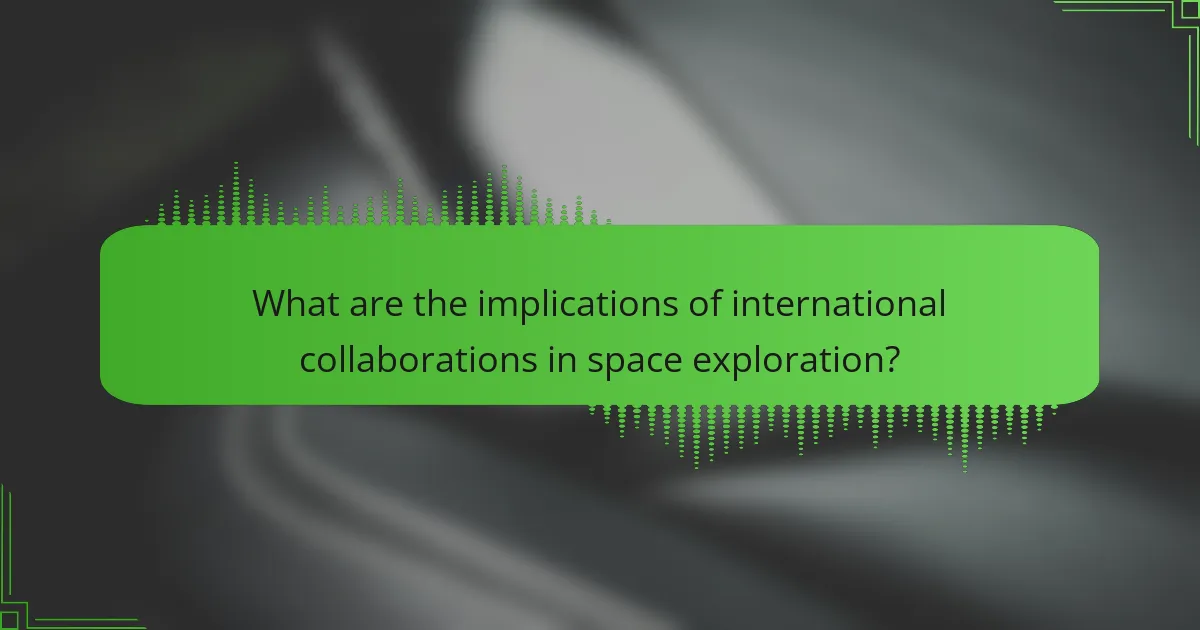
What are the implications of international collaborations in space exploration?
International collaborations in space exploration enhance resource sharing, technology transfer, and scientific knowledge. These partnerships lead to more ambitious missions and reduce costs through pooled funding. Collaborative projects like the International Space Station demonstrate successful teamwork, fostering innovation. Such alliances also promote peaceful relations among nations, creating a unified approach to address global challenges like climate change and asteroid threats.
How does the International Space Station facilitate global partnerships?
The International Space Station fosters global partnerships by enabling collaborative research and technology development among nations. This collaboration enhances scientific discovery and promotes peaceful international relations. Countries share resources, expertise, and funding, resulting in innovative advancements in space exploration. The ISS serves as a platform for training astronauts from various nations, further strengthening these partnerships. Additionally, joint missions and experiments conducted aboard the ISS exemplify the power of international cooperation in addressing global challenges.
What are the benefits of joint missions between countries?
Joint missions between countries enhance collaboration, share costs, and combine expertise, leading to more successful space exploration. They foster innovation through diverse technological contributions and create a unified approach to addressing global challenges. For instance, partnerships in the International Space Station have accelerated research and development, demonstrating the power of shared objectives. Additionally, joint missions promote peaceful international relations, strengthening ties between nations while advancing scientific knowledge and exploration.

What unique attributes differentiate various space agencies?
Various space agencies are differentiated by their unique attributes, such as mission focus, technological capabilities, and international collaborations. NASA emphasises human spaceflight and deep space exploration, while ESA focuses on Earth observation and climate research. Roscosmos excels in launching heavy payloads and long-duration missions. CNSA is advancing rapidly in lunar exploration and Mars missions. ISRO is known for cost-effective satellite launches and innovative technologies. JAXA integrates robotics and international partnerships in its projects.
How do the goals of ESA compare to those of NASA?
The goals of ESA focus on Earth observation and climate monitoring, while NASA emphasises human space exploration and scientific research. ESA aims to enhance international collaboration in space science, whereas NASA prioritises technological innovation for missions to the Moon and Mars. Both agencies share interests in space science but differ in their strategic objectives and mission scopes.
| Agency | Primary Goals | Focus Areas | Future Missions |
|——–|—————|————-|—————–|
| ESA | Earth observation, climate monitoring | International collaboration, space science | Lunar Gateway, Mars Sample Return |
| NASA | Human space exploration, scientific research | Technological innovation, Mars missions | Artemis programme, Mars Artemis missions |
What innovative approaches are emerging from China’s space programme?
China’s space programme is adopting innovative approaches, emphasising reusable rocket technology and lunar exploration. These advancements aim to reduce costs and enhance mission efficiency. For instance, the Long March 9 rocket will support crewed missions to the Moon by 2030. Additionally, China is collaborating on international projects, such as the Lunar Gateway, to foster global partnerships in space exploration. These strategies position China as a leader in the evolving landscape of space travel.
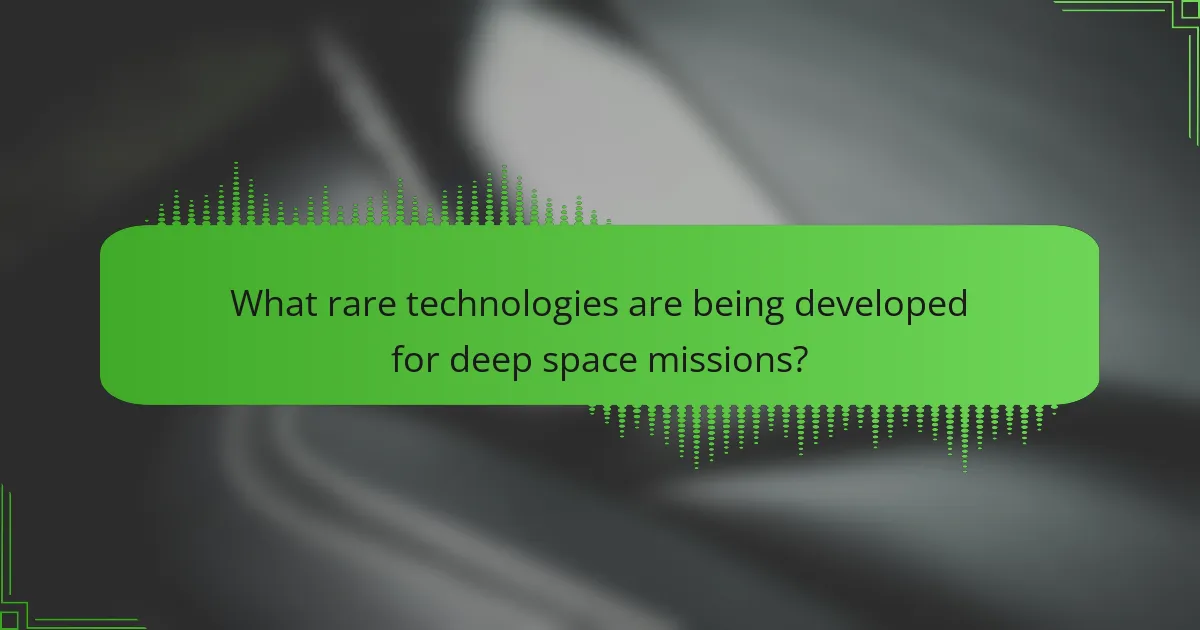
What rare technologies are being developed for deep space missions?
Rare technologies being developed for deep space missions include advanced propulsion systems, autonomous robotics, and in-situ resource utilisation technologies. These innovations aim to enhance mission efficiency and sustainability.
One notable development is the ion propulsion system, which offers higher efficiency compared to traditional chemical rockets. Another is the use of 3D printing to create tools and components from local materials, reducing the need for extensive supplies from Earth.
Additionally, autonomous systems are being designed to operate independently on distant planets, allowing for real-time data collection and analysis. These technologies represent significant advancements in the field of space travel.
How are ion propulsion systems changing space travel dynamics?
Ion propulsion systems are revolutionising space travel by providing efficient, long-duration thrust. These systems utilise electric fields to accelerate ions, enabling spacecraft to achieve higher speeds with less fuel. This technology allows for extended missions, such as deep-space exploration, where traditional propulsion methods would be impractical. As a result, ion propulsion is critical for future missions targeting distant planets and asteroids, enhancing our capabilities in space exploration.
What advancements in life support systems are crucial for Mars missions?
Advancements in life support systems crucial for Mars missions include enhanced recycling of air and water, improved radiation protection, and efficient food production methods. These technologies ensure astronaut safety and sustainability during long-duration space travel.
Key developments involve closed-loop systems that recycle waste, advanced habitats that shield against cosmic radiation, and hydroponic farming techniques that provide fresh food. For instance, the use of bioregenerative life support systems can significantly reduce resource dependency from Earth.
These innovations are essential for future missions, enabling extended stays on Mars while minimising logistical challenges. As a result, they play a vital role in the feasibility of human exploration beyond Earth.

What best practices should be followed for aspiring space travellers?
Aspiring space travellers should prioritise safety, training, and physical fitness. They must understand the risks and prepare for the challenges of space travel.
1. Research reputable space travel companies and their safety records.
2. Engage in rigorous physical training to meet health requirements.
3. Complete necessary astronaut training programmes, focusing on survival skills.
4. Stay informed about technological advancements in space travel.
5. Network with experienced space travellers for insights and advice.
How can individuals prepare for potential future space tourism?
Individuals can prepare for potential future space tourism by enhancing physical fitness, gaining relevant knowledge, and understanding safety protocols.
First, maintaining good physical health is crucial, as space travel can be physically demanding. Regular exercise and a balanced diet can improve stamina and resilience.
Second, educating oneself about space travel, including spacecraft operations and potential experiences, will foster preparedness and reduce anxiety.
Lastly, familiarising with safety protocols and emergency procedures of space tourism companies is essential. This knowledge enhances confidence and ensures a safer experience.
What common mistakes should be avoided in space mission planning?
Common mistakes in space mission planning include inadequate risk assessment, insufficient funding, and lack of clear objectives. These errors can lead to mission failure and wasted resources. Effective planning requires a thorough analysis of potential challenges, realistic budgeting, and well-defined goals. Prioritising these elements enhances mission success rates.
